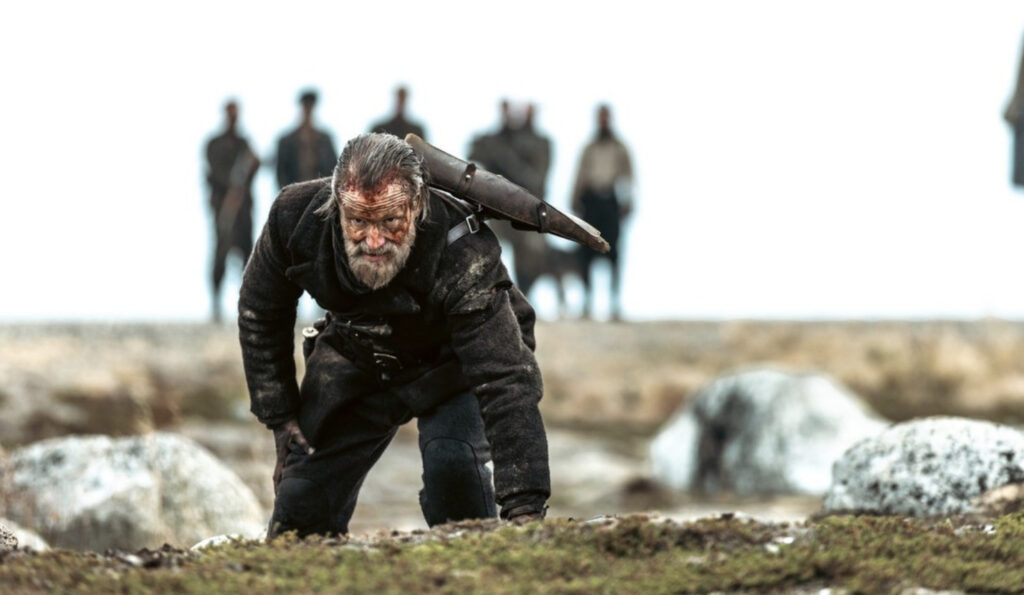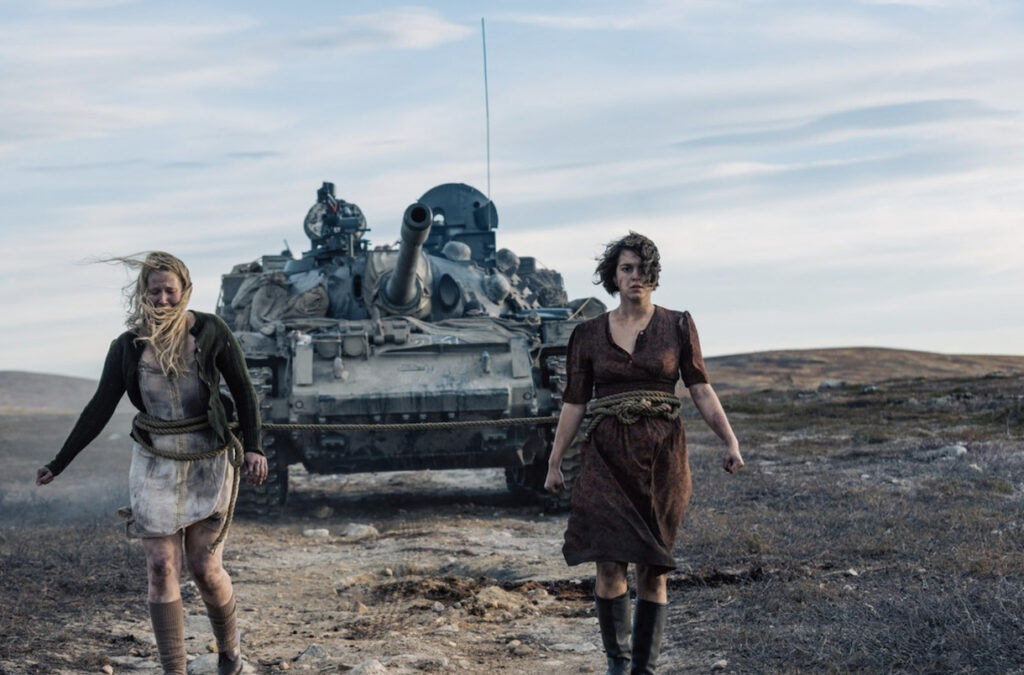
Synopsis : During the last desperate days of WWII, a solitary prospector (Jorma Tommila) crosses paths with Nazis on a scorched-earth retreat in northern Finland. When the Nazis steal his gold, they quickly discover that they have just tangled with no ordinary miner. While there is no direct translation for the Finnish word “sisu”, this legendary ex-commando will embody what sisu means: a white-knuckled form of courage and unimaginable determination in the face of overwhelming odds. And no matter what the Nazis throw at him, the one-man death squad will go to outrageous lengths to get his gold back — even if it means killing every last Nazi in his path.
Rating: R (Strong Bloody Violence|Language|Gore)
Genre: Action
Original Language: Finnish
Director: Jalmari Helander
Producer: Petri Jokiranta
Writer: Jalmari Helander
Release Date (Theaters): Wide
Box Office (Gross USA): $3.3M
Runtime:
Distributor: Lionsgate
Production Co: Subzero Film Entertainment, Good Chaos

Exclusive Interview with Writer/Director Jalmari Helander
Q : Not many people outside of Finland know about the Lapland War in 1944. How did you decide to set a story during the Lapland War? What kind of research did you do to tap into this project?
J.H: In the beginning, I only had an idea about a man finding a lot of gold in Lapland. I had that idea for many, many, many, many years. But I was thinking one day about the war in Lapland and what the Nazis did. They basically destroyed everything there — every village, city, bridge, railroad, road, everything. I suddenly was thinking about this guy who finds the gold. It felt so good when I finally developed the trouble for the guy who finds the gold — that he has to conquer the Nazis to be able to keep his gold in the end. I read a lot about that time, what was going on in Finland back then. I felt it’s really good for the movie to have that kind of setting with a lot of danger. Everything is destroyed and you can’t get help from anywhere — you have mines on the road [and such]. It felt like a movie to me.
Q : What’s amazing about this film was how you shot it in Lapland, Finland, which is really a vast land. It’s difficult to frame and compose a shot. How did you work with the cinematographer to frame the shot and did you write a storyboard prior to that?
J.H: I think of everything through pictures. If you read the script of Sisu you could basically see how this would look like. I made storyboards for every important scene, to be able to plan how we’re going to do something and explain to the crew and everyone what I’m aiming for. I’ve worked with the DOP many times before and he knows my style. We were lucky enough to have nice weather in Lapland with the clear skies and stuff like that so that it looked like a western.
Q : This film relies on lead actor Jorma Tommila’s performance, not just with the acting, but also because it physically requires a lot of performance on that as well. What was the process of casting Jorma in this movie
J.H: It wasn’t a process at all because basically everything is built around Jorma. From the first second I had this idea, I knew that Jorma had to be the guy who was going to do this. I knew it was going to be really fucking difficult to be doing that role and not to speak but still be interesting for the audience — keeping them understanding what you are basically thinking. It’s a really physical role to do. I needed someone I really could trust.

Q : There’s a scene of the atomic corps sneaking around the track holding the pipe while the track is still running. There’s a horse stepping into the live mine and getting blown up. There are a lot of difficult scenes to shoot. How did you work with the stunt guys to produce those really creative and original scenes?
J.H: Of course, it starts with good planning. I first try to write a good idea of what we are trying to do. Then I make a storyboard out of it. With the pictures on the storyboard, we figure out what’s the best way to shoot. That’s the key element in making a storyboard. Before the storyboard, it’s so hard to understand the whole thing and how it will look. Every time it happens when you make a storyboard, you understand, “Okay, we can do this. We’re going to see this and then we’re going to see that.” How are we going to do that? I didn’t know. It was a good process. I like thinking of solutions to things like that.
Q : I heard that you used a hundred kilograms of dynamite in the third act of the movie. How did you convince Sony or Lionsgate to let you shoot the film the way you wanted to and have such freedom to shoot it that way?
J.H: Me and producer Petri Jokiranta have our own company. When I wrote the script, it was clear from the beginning that this was the movie we are going to make. It’s all on the page there. If somebody is willing to have that idea, they know what they’re going to get, basically. We didn’t have any kind of conversation about that at all, because It was fair game from the beginning. This is what you’re going to get to do — and everybody wanted it. It was a really good process. No one gave me any kind of restrictions on what I could or couldn’t do.
Q : What were the challenges you faced while you were shooting there? Was it the temperature or something like snowing or bringing the tank to an isolated area? What were the challenges that you faced while shooting there?
J.H: The biggest challenge was the wind. There were no trees in the area and the wind was blowing hard. It made everything really difficult because you can’t even speak to each other. You have to shout. It’s freezing cold and so exhausting to be in a strong wind every day. I’m lucky that we all survived up there.

Q : The film was shown during the Toronto International Film Festival last year. What was the reception there like? What was the thing that surprised you about the audience reaction there?
J.H: The reception was better than I ever imagined. Like I’ve been saying, when the first kill happens in the film, it was like I was at a rock concert. People were cheering, shouting, clapping all the way to the end. I had so much fun with that.
Q : What was the casting process in order to find the people who played the villains? How did you find Aksel Hennie, who played Bruno, and Jack Doolan, who played Wolf? Those were really key characters who represented the villainous Nazis, characters who were dominating and very scary.
J.H: I always wanted to work with Aksel Hennie. It started when I saw the film “Headhunters.” We called him, he read the script and he called me back. He understood everything that I was aiming for. It went really quickly with Axel and I think he was a great choice to play Bruno. Doolan is from the UK. And he’s like a beast of a man, like a football hooligan in a way. I wanted to have somebody who looks unpredictable, like a guy who’s willing to do whatever he’s told to do — while having fun doing it. I wanted them to be scary guys.
Q : What are you working on next? Do you still want to make films in Finland or do you want to launch into making movies in the US. This movie is like a Rambo type of film — you could do other series. What’s the next project you have in mind?
J.H: I’m writing an action film at the moment which we will do someday. There’s also some projects coming from Hollywood which I find interesting. I’m not sure yet. I just have to see what is happening.
Q : After this film, you’re going to blow up like crazy. You’re destined to be a great director. What do you want audiences to take away from this film? It’s a great cinematic experience, a wonderful experience.
J.H: I want the audience to enjoy themselves, being entertained in a way that they never guessed. I want to surprise them with all the stuff that’s happening in the film. I want them to come out of the cinema with a big smile on their faces, telling all their friends that they have to see this film.

Check out more of Nobuhiro’s articles.
Here’s the trailer of the film.

